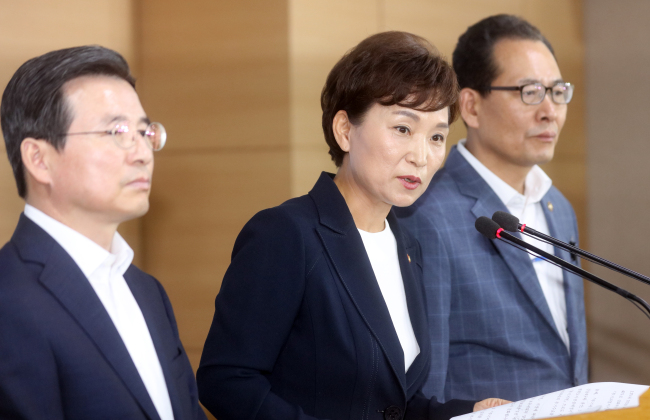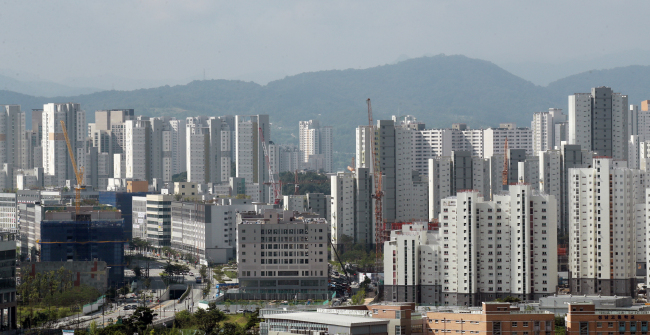Ministry unveils tough measures to calm overheating housing market
By Son Ji-hyoungPublished : Aug. 2, 2017 - 16:33
South Korea unveiled Wednesday a tighter set of real estate market rules aimed at taming speculation and deterring the rise of housing prices in what is considered to be the strongest set of measures in nearly six years.
Starting Thursday, the capital Seoul, the administrative city Sejong and Gwacheon will be named “overheated speculative districts,” with the loan limits of those buying homes there to be tightened to 40 percent of their property value from the current 60 percent, according to the plan. The debt payment will be capped at 40 percent of income, 10 percentage points tighter.
Eleven districts in Seoul and Sejong City have also been designated “speculative districts” subject to higher taxes and tougher regulations.
These are the first designations of the overheated speculation districts since December 2011.
The administration will stay consistent in prioritizing home price stabilization, Land, Infrastructure and Transport Minister Kim Hyun-mee said during a press conference Wednesday.
Starting Thursday, the capital Seoul, the administrative city Sejong and Gwacheon will be named “overheated speculative districts,” with the loan limits of those buying homes there to be tightened to 40 percent of their property value from the current 60 percent, according to the plan. The debt payment will be capped at 40 percent of income, 10 percentage points tighter.
Eleven districts in Seoul and Sejong City have also been designated “speculative districts” subject to higher taxes and tougher regulations.
These are the first designations of the overheated speculation districts since December 2011.
The administration will stay consistent in prioritizing home price stabilization, Land, Infrastructure and Transport Minister Kim Hyun-mee said during a press conference Wednesday.

“The government will neither tolerate any activities that turn houses into tools for speculative purchases, nor consider the real estate market as a means to stimulate the national economy,” Kim said.
She also hinted at imposing regulations on additional regions where speculation was observed.
The pan-governmental pre-emptive measure is a step on from the Moon Jae-in administration’s first restriction package unveiled on June 19, which had aimed to put a lid on the build-up of household debt.
The first measures were designed to prevent the resale of home purchasing rights of real estate assets in Seoul, while tightening the bars for maximum mortgage loans for home buyers to 60 percent of a property’s value from 70 percent, and maximum debt repayments to 50 percent from 60 percent.
But the new lending limits, which became effective on July 3, failed to halt the surge in housing prices. The average apartment price nationwide surged 0.09 percent as of July 24 from a week prior, the fastest clip in about 10 months, according to data from Kookmin Bank. In Seoul, the price soared 0.26 percent over the cited period, the highest since the June lending restriction plans were announced.
Coupled with the monetary expansion by the central bank involving eight rate cuts since 2012, deregulations of the lending limits of home buyers in 2015 had fueled property trading and speculation.
Easier lending rules also helped increase national household debt, which stands at 1,286.6 trillion won ($1.14 trillion), as of the first quarter of 2017.
On-year, the volume of household loans began to surge about 10 percent starting 2015, compared to the previous three years when it rose around 6 percent, according to data from the Bank of Korea.
She also hinted at imposing regulations on additional regions where speculation was observed.
The pan-governmental pre-emptive measure is a step on from the Moon Jae-in administration’s first restriction package unveiled on June 19, which had aimed to put a lid on the build-up of household debt.
The first measures were designed to prevent the resale of home purchasing rights of real estate assets in Seoul, while tightening the bars for maximum mortgage loans for home buyers to 60 percent of a property’s value from 70 percent, and maximum debt repayments to 50 percent from 60 percent.
But the new lending limits, which became effective on July 3, failed to halt the surge in housing prices. The average apartment price nationwide surged 0.09 percent as of July 24 from a week prior, the fastest clip in about 10 months, according to data from Kookmin Bank. In Seoul, the price soared 0.26 percent over the cited period, the highest since the June lending restriction plans were announced.
Coupled with the monetary expansion by the central bank involving eight rate cuts since 2012, deregulations of the lending limits of home buyers in 2015 had fueled property trading and speculation.
Easier lending rules also helped increase national household debt, which stands at 1,286.6 trillion won ($1.14 trillion), as of the first quarter of 2017.
On-year, the volume of household loans began to surge about 10 percent starting 2015, compared to the previous three years when it rose around 6 percent, according to data from the Bank of Korea.

In the latest attempt, the government said the resale of new homes in the designated areas would be restrained in “overheated speculative districts” until the transition of property ownership was complete. Those trading real estate assets valued at over 300 million won in the area should submit additional documents to prove their financial health and their plans for residence.
In addition, mortgage borrowing will be limited to once per household owning real estate in one of the 11 “overheated” districts in Seoul, including pricey areas such as Gangnam-gu and the adjacent Seocho-gu, as well as Sejong City, starting Thursday. Previously, the regulation was applied to an individual instead of a household.
Those owning multiple homes in Seoul, Sejong City, parts of Gyeonggi Province and Busan are also subject to the regulation. An owner of two homes will be imposed additional transfer income tax by 10 percentage points, while an owner of more than three homes will see the tax increased by 20 percentage points, starting April 2018. Also, their loan-to-value ratio and debt-to-income ratio would be toughened by 10 percentage points, if the parliament passes the revision of the Income Tax Act, projected to be in late August.
“(The government) observed the unfavorable signs sparked by the sprawling speculation, despite the stable supply of houses,” said Park Seon-ho, head of the housing and land office at the ministry. “If this sign persists, this could undermine the real estate market as a whole.”
Park added the government sees the housing market as “tamed” when housing prices increase nearly to the level of consumer price inflation or economic growth.
Home transactions by those who already owned homes accounted for 43.7 percent on average from 2013 to May 2017, compared to the average of 31.3 percent between 2006 and 2007, the ministry said. Home buyers in Seoul were twice more likely to have owned multiple homes, accounting for 13.9 percent of home buyers in general in 2016 from 6 percent the previous year, it added. The figure remained nearly flat at 13.8 percent as of the first half of 2017.
By Son Ji-hyoung (consnow@heraldcorp.com)
In addition, mortgage borrowing will be limited to once per household owning real estate in one of the 11 “overheated” districts in Seoul, including pricey areas such as Gangnam-gu and the adjacent Seocho-gu, as well as Sejong City, starting Thursday. Previously, the regulation was applied to an individual instead of a household.
Those owning multiple homes in Seoul, Sejong City, parts of Gyeonggi Province and Busan are also subject to the regulation. An owner of two homes will be imposed additional transfer income tax by 10 percentage points, while an owner of more than three homes will see the tax increased by 20 percentage points, starting April 2018. Also, their loan-to-value ratio and debt-to-income ratio would be toughened by 10 percentage points, if the parliament passes the revision of the Income Tax Act, projected to be in late August.
“(The government) observed the unfavorable signs sparked by the sprawling speculation, despite the stable supply of houses,” said Park Seon-ho, head of the housing and land office at the ministry. “If this sign persists, this could undermine the real estate market as a whole.”
Park added the government sees the housing market as “tamed” when housing prices increase nearly to the level of consumer price inflation or economic growth.
Home transactions by those who already owned homes accounted for 43.7 percent on average from 2013 to May 2017, compared to the average of 31.3 percent between 2006 and 2007, the ministry said. Home buyers in Seoul were twice more likely to have owned multiple homes, accounting for 13.9 percent of home buyers in general in 2016 from 6 percent the previous year, it added. The figure remained nearly flat at 13.8 percent as of the first half of 2017.
By Son Ji-hyoung (consnow@heraldcorp.com)









![[Kim Seong-kon] Democracy and the future of South Korea](http://res.heraldm.com/phpwas/restmb_idxmake.php?idx=644&simg=/content/image/2024/04/16/20240416050802_0.jpg&u=)








![[KH Explains] Hyundai's full hybrid edge to pay off amid slow transition to pure EVs](http://res.heraldm.com/phpwas/restmb_idxmake.php?idx=652&simg=/content/image/2024/04/18/20240418050645_0.jpg&u=20240418181020)

![[Today’s K-pop] Zico drops snippet of collaboration with Jennie](http://res.heraldm.com/phpwas/restmb_idxmake.php?idx=642&simg=/content/image/2024/04/18/20240418050702_0.jpg&u=)